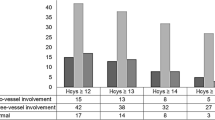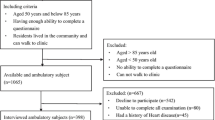Abstract
Myocardial infarction is a major consequence of coronary artery disease. Apart from the traditional risk factors of myocardial infarction, recently many reports have suggested that hyperhomocysteinemia plays important role in myocardial infarction. Plasma homocysteine level was determined in 60 myocardial infarction patients and in 35 age matched healthy individuals. Statistically significant differences (p<0.01) were observed in the mean of plasma homocysteine concentrations between the acute myocardial infarction patients (24.59±6.14 mM/L) and in normal healthy individuals (13.73 ±3.54 mM/L). The level of homocysteine in myocardial infarction patients is significantly high (p <0.01) among myocardial infarction patients when compared to that of the controls. The the present study indicates a strong association between plasma homocysteine and acute myocardial infarction among Tamilians, thus implying plasma homocysteine as a possible risk factor for myocardial infarction.
Similar content being viewed by others
References
Lin, T.K. and Liou, W.S. (2002) The concept of B vitamins in prevention of cardiovascular diseases. J Med Sci. 22(6):273–276.
Neki, N.S., (2003) Hyperhomocysteinaemia—An Independent Risk factor for Cardio-vascular Diseases. JIACM. 4, 55–60.
Mudd, S.H., Levy, H.L., and Scovby, F., (1989) Disorders of transsulfuration. The metabolic basis of inherited disease, 6th edn, Mc Graw Hill, New York. 693–734.
Chambers, J.C., Obeid, O.A., Refsum, H., Ueland, P., Hackett, D., Hooper, J., Turner, R.M., Thomson, S.G. and Kooner, J.S. (2000) Plasma homocysteine concentrations and risk of coronary heart disease in U.K. Indian Asian and European men. Lancet. 355, 523–527.
Boushey, C.J., Beresford, S.A. and Omenn, G.S. (1995) A quantitative assessment of plasma homosysteine as a risk factor for cardiovascular disease: probable benefits of increasing folic acid intakes. JAMA. 274, 1049–1057.
Senaratne, M.P.J., Griffiths, J. and Nagendran J.N. (2000) Elevation of plasma homocysteine levels associated with acute myocardial infarction. Clin Invest Med. 23(4): 220–226.
Nair, K.G., Nair, S.R., Ashavaid, T.F., Dalal, J.J. and Eghlim F.F. (2002) Methylenetetrahydrofolate reductase gene mutation and hyperhomocysteinemia as a riskfactor for coronary heart disease in the Indian population. J Assoc Physicians India. 50:9–15.
Deepa, R., Velmurugan K, Saravanan, G., Karkuzhali K., Dwarakanath V. and Mohan, V. (2001) Absence of association between serum homocysteine levels and coronary artery disease in South Indian males. Indian Heart J. 53:44–47.
Chacko, K.A. (1998) Plasma homocysteine levels in patients with coronary heart disease. Indian Heart J. 50:295–199.
Ueland, P.M., Refsum, H., Stabler, S.P., Malinow, M.R., Andersson, A., Allen, R.H. (1993) Total homocysteine in plasma or serum: methods and clinical applications. Clin chem. 39:1764–1779.
Anand, S.S., Yusuf, S., Vuksan, V., Devanesan, S., Teo, K.K., et al., (2000) Difference in risk factors, atherosclerosis and cardiovascular disease between ethnic groups in Canada; the study if health assessment and risk in ethnic groups(SHARE). Lancet. 356, 279–284.
Stampfer, M.J., Malinow, M.R. and Willette, W.C. (1992) A prospective study of plasma homocysteine and risk of myocardial infarction in United States physicians. JAMA. 268, 877–881.
Prasad, K. (1999) Homocysteine, a risk factor for cardiovascular disease. Int. J of Angiol. 8, 76–86.
Miller, A.L. Cardiovascular disease—Toward a Unified approach. (1996). Alt Med Rev. 3, 132–147.
Haynes, W.G. (2000) Homocysteine and atherosclerosis: potential mechanisms and clinical implications. Proc. R. Coll. Physicians Edinb. 30, 114–122.
Author information
Authors and Affiliations
Corresponding author
Rights and permissions
About this article
Cite this article
Angeline, T., Aruna, R.M., Ramadevi, K. et al. Homocysteine status and acute myocardial infarction among Tamilians. Indian J Clin Biochem 20, 18–20 (2005). https://doi.org/10.1007/BF02893035
Issue Date:
DOI: https://doi.org/10.1007/BF02893035




